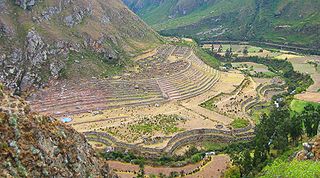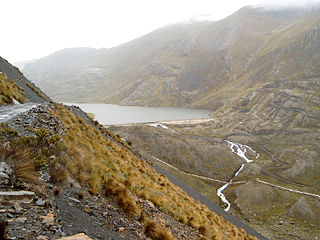Related Research Articles
The Inca Empire was the largest empire in pre-Columbian America.

Inkallaqta is a monumental Inca site in central Bolivia. It is located in the Cochabamba Department, Carrasco Province, Pocona Municipality, approximately 130 kilometers east of Cochabamba. It was most recently excavated by Larry Coben.He believes that the site was used to perform rites for the ceremonial calendar. The site has several important structures such as the Kallanka. It was the largest single roofed room in the western hemisphere when it was built, and measures 78 by 25 meters. There's also an ushnu or a ritual platform on the site. The Torreon of Inkallaqta is also located on this site. Located at the western side of the site this six sided structure supposedly had calendrical or astronomical significance. There is a zigzag wall immediately north of the site which is meant to mark and protect it.

The Inca Bridge or Inka Bridge refers to one of two places related to access to Machu Picchu, in Peru.
Inka Wasi or Inkawasi may refer to:
Isla Incahuasi, Inkawasi or Inka Wasi is a hilly and rocky outcrop of land and former island in Bolivia situated in the middle of Salar de Uyuni, the world's largest salt flat, at an elevation of 3,656 meters. It is located in the Potosí Department, Daniel Campos Province, Tahua Municipality, Yonza Canton.

Cusichaca River, is a river in Peru located in the Cusco Region, Urubamba Province, on the border of the districts Machupicchu and Ollantaytambo. Its waters flow to the Vilcanota River.

Inkachaka Dam is a dam in Bolivia situated in the La Paz Department, Pedro Domingo Murillo Province, La Paz Municipality, north east of La Paz.
Inka Wasi is a Bolivian river in the Chuquisaca Department, Nor Cinti Province. It is a left tributary of the Pilaya River, an important right affluent of the Pillku Mayu.

Inka Wasi is an archaeological site in the Huancavelica Region in Peru. The Inca palace is considered one of the most important monuments of the Huancavelica Region. Inka Wasi is located in the Huaytará Province, Huaytará District, about 25 km from Huaytará. It is situated at a height of 3,804 m (12,480 ft).
Inka Raqay or Inkaraqay is a small archaeological complex in Peru. It lies in the Apurímac Region, Abancay Province, Cachora District. Inka Raqay is situated at a height of 3,590 metres (11,778 ft) on the northern slope of Inka Wasi south of the archaeological site of Choquequirao, above the Apurímac River.

Inka Raqay is an archaeological site in Bolivia. It is located in the Cochabamba Department, Quillacollo Province, Sipe Sipe Municipality, near the community of Linku.
Inka Mach'ay is an archaeological site in Peru. It is situated in the Huancavelica Region, Tayacaja Province, Ñahuimpuquio District.

Inka Mach'ay is an archaeological site in Bolivia. It is situated in the Chuquisaca Department, Oropeza Province, Sucre Municipality, at a height of 3,510 metres (11,516 ft). Inka Mach'ay was declared a National Monument on May 27, 1958, by Supreme Decrete No. 4954.
Inka Tampu or Inkatampu is an archaeological site in Peru. It is located in the Cusco Region, La Convención Province, Vilcabamba District. The archaeological group is situated on top of a mountain named Inka Tampu (Inka Tambo).

Maray Qalla is an archaeological site in Peru. It is situated in the Ancash Region, Carlos Fermín Fitzcarrald Province. Maray Qalla lies at a section of the Qhapaq Ñan, the Inca road system.
Tinyaq or Quri Willka is an archaeological site in Peru with storehouses of the Inca period on a mountain named Tinyaq. It is located in the Ayacucho Region, Huanta Province, Iguain District.
Inka Raqay hispanicized spelling Incaraqay) or Allqu Willka(Allcuhuillca, Alkowillka) is an archaeological site in the Ayacucho Region in Peru. It is located in the Huanta Province, Iguain District, on top of the mountain named Allqu Willka.
Inka Raqay or Inkaraqay may refer to:

Inka Paqcha is a mountain in the Andes of Peru, about 4,400 metres (14,436 ft) high. It is located in the Ayacucho Region, Lucanas Province, Carmen Salcedo District. Inka Paqcha lies northwest of Inka Pallanka where the archaeological site of Quriwayrachina is situated.
Victoriano Arizapana Huayhua is a Quechua master rope bridge engineer, notable for being the lead builder of the Q'iswa Chaka, which is the last remaining traditionally built Inca rope bridge and a part of the historical Qhapaq Ñan Inca road network. He is also a teacher and cultural figure, preserving and transmitting to future generations the bridgebuilding techniques passed to him by his ancestors.
References
- ↑ Teofilo Laime Ajacopa, Diccionario Bilingüe Iskay simipi yuyayk'ancha, La Paz, 2007 (Quechua-Spanish dictionary)
- ↑ "Bolivia: Ley Nº 2533, 24 de octubre de 2003". lexivox.org. Retrieved May 20, 2014.